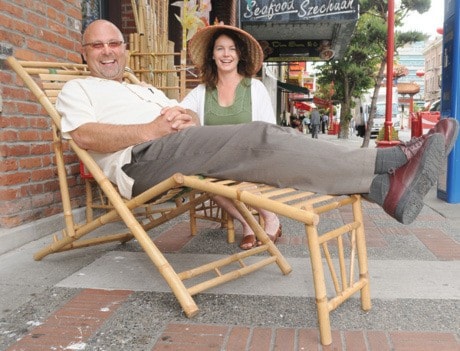DOWNTOWN: Central living vibrant, but requires patience
Balcony gardening is piquing the interest of downtown residents these days.
After launching one successful workshop, Wendy Bowkett has arranged a second at the Silver Threads seniors’ centre.
It’s about growing on a vertical plane, said Bowkett, whose to-do list also includes a series of raising-the-rooftop-garden parties for downtown residents.
Attracting and retaining downtown residents is a key strategy for city hall, to build a healthy downtown where commercial activity thrives outside the work day.
According to representatives of downtown residents, these efforts are paying off.
Tax incentives have helped convert aging heritage buildings into condos. Improvements to Centennial Square have transformed the once deserted space.
“I was totally amazed by the very first nice day this year, there were kids playing Frisbee, there were people having picnics,” said Bowkett. She is co-chair of the Downtown Residents’ Association, but qualified her comments only represent her own opinion.
Walkability and vibrancy rank high for residents who are enthusiastic advocates for downtown living, despite facing serious challenges.
“I can walk to work,” said Cathy Brankston, who has lived downtown since 1986. “There’s so much diversity for shopping.”
Hugh Kruzel, co-chair of the association, said his teenage daughter has ample activities close to home. And that means there’s no dad’s taxi service required.
Downtown living isn’t all trendy restaurants, local market places and arts festivals, however.
As president of his strata in Harris Green, Kruzel makes daily calls to police for prostitution, drug injection and other disturbances.
Last night, for instance, a police dog woke him at 2 a.m. and he admits he’s been tempted to move a few times. Street issues, in part, influced his teenage son to leave.
“His classmate was killed in front of the Times Colonist (building),” he said, referring to Justin Wendland.
He emphasizes, however, that street disorder is noticeably improving.
Bowkett, who lives near Chinatown, faces different, but less serious challenges, such as kids climbing the fire escapes and loud motorcycles circling the block.
A city study from 2007 indicates most new condo owners in the core are young professionals or mature singles or couples. “None of the Downtown projects currently marketing is attracting a significant number of families.”
Bowkett and Kruzel, however, insist the neighbourhood defies categorization: families with kids do live downtown, and condos sell at a variety of price points.
Pricing, however, is a factor for some.
The longtime voice of the DRA, Rob Randall, recently left for Saanich. “We were pretty much priced out of Victoria,” said Randall, via email.
“I fear there has not been as much progress as we had hoped. The influx of new residents has slowed and while many new businesses have opened, many have closed.”
Still, downtown is one of the city’s fastest growing neighbourhoods. The Aria, the Astoria, the Hudson and the Juliet have all sprung up in recent years, making the 2006 Census population estimate out of date.
Since community funding is tied to this number, the formula shortchanges the DRA, leaving them wanting for a new website and a community centre.
“I think it’s harder to connect with residents in a community like this (because) people are coming from everywhere and the downtown belongs to everyone,” Bowkett said. For this reason, having a physical space to connect would help, she explained.
Downtown Core Area Plan
Over the next 30 years, 10,000 people are predicted to move to the downtown core, up from a 2008 estimate of 6,050. The city’s challenge is to keep up with demand for space.
That means, in part, rezoning for much higher densities along the Douglas corridor and Harris Green. The core encompasses the downtown proper, plus dense bordering areas.
The draft Downtown Core Area Plan also calls for preservation of the heritage district; a push to stimulate light industry in Rock Bay; three new parks and the completion of the Harbour Pathway.
The principles are generally supportable, according to members of the Downtown Residents’ Association. But there are qualifications.
The controversial density bonus system, for example, needs more clarity, said co-chair Wendy Bowkett, speaking only for herself.
If adopted, developers would contribute toward a public-amenities and heritage-preservation fund, in exchange for being granted extra density beyond the area’s zoning allowance.
Asked Bowkett: What defines a public amenity? She points to the Union, a mixed-use development proceeding in Chinatown. The developer has offered Theatre Alley as a boon to the public, yet offered no covenant to prevent the future condo strata from gating it for private use, she explained.
Added co-chair Hugh Kruzel: offering bonus density threatens to negate the city’s careful planning, potentially leading to big buildings in the wrong places.
Now it’s your turn to weigh in. City council sent the draft plan to a non-statutory public hearing, scheduled for early fall.
